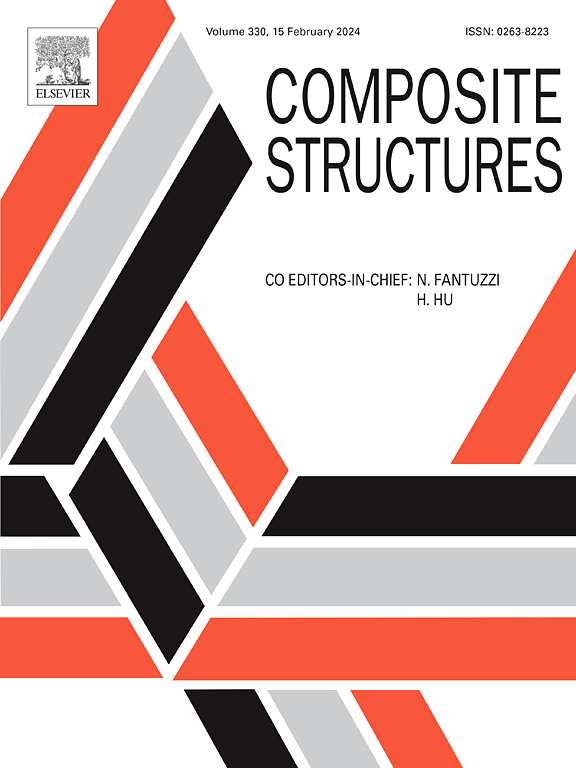Material extrusion 3D printing of synergistically enhanced conductive poly(lactic) acid polymer composites with reduced graphene oxide and glass fibers for high-performance electronic applications
IF 6.3
2区 材料科学
Q1 MATERIALS SCIENCE, COMPOSITES
引用次数: 0
Abstract
Electrically conductive polymer composites have emerged as a pivotal material in polymer science, offering enhanced properties by integrating conductive nanofillers with pure polymers. The material extrusion-based (MEX) 3D printing of these composites is well-known for yielding high-quality parts. In this study, a novel approach involving a modified four-extrusion strategy was utilized to synthesize a reinforced conductive poly(lactic) acid polymer composite with reduced graphene oxide (RGO) and short glass fibers (SGFs). This work comprehensively studies the thermal degradation, thermodynamic, morphological, and electrical properties, alongside with a focus on optimizing the MEX 3D printing process for enhanced performance. Optimal printing parameters significantly influencing the surface roughness and tensile properties of the printed parts were found, including a layer thickness of 0.10 mm, a nozzle temperature of 205 °C, a flat print orientation, an infill speed of 72.55 mm/s, and an infill density of 99.9 %. The minimum surface roughness was achieved for the PLA composites is 3.67 µm (14.6 %) lower than the pure PLA. The incorporation of nanofillers will improve the layer deposition and accumulation of materials. The incorporation of reinforcements into the composite material resulted in substantial improvements in the overall performance, with tensile strength, yield strength, breaking strength, and elastic modulus being increased by 85.4 %, 58.4 %, 101 %, and 128 %, respectively. The composites developed in this research exhibit promising potential for applications within the electrical and electronics industries, showcasing their versatility and performance advantages in advanced material science.
材料挤出3D打印协同增强导电聚(乳酸)酸聚合物复合材料与还原氧化石墨烯和玻璃纤维,用于高性能电子应用
导电聚合物复合材料已成为聚合物科学领域的一种重要材料,它通过将导电纳米填料与纯聚合物相结合而增强了性能。基于材料挤压(MEX)的三维打印技术因能打印出高质量的部件而闻名。在本研究中,采用了一种新方法,即改良的四挤压策略,合成了一种含有还原氧化石墨烯(RGO)和短玻璃纤维(SGF)的增强型导电聚(乳)酸聚合物复合材料。这项工作全面研究了热降解、热力学、形态学和电学特性,并重点优化了 MEX 3D 打印工艺以提高性能。研究发现了对打印部件的表面粗糙度和拉伸性能有重大影响的最佳打印参数,包括层厚 0.10 毫米、喷嘴温度 205 °C、平面打印方向、填充速度 72.55 毫米/秒和填充密度 99.9 %。聚乳酸复合材料的最小表面粗糙度比纯聚乳酸低 3.67 微米(14.6%)。纳米填料的加入将改善材料层的沉积和堆积。在复合材料中加入增强材料后,复合材料的整体性能有了大幅提高,拉伸强度、屈服强度、断裂强度和弹性模量分别提高了 85.4%、58.4%、101% 和 128%。这项研究开发的复合材料在电气和电子行业的应用潜力巨大,展示了其在先进材料科学领域的多功能性和性能优势。
本文章由计算机程序翻译,如有差异,请以英文原文为准。
求助全文
约1分钟内获得全文
求助全文
来源期刊

Composite Structures
工程技术-材料科学:复合
CiteScore
12.00
自引率
12.70%
发文量
1246
审稿时长
78 days
期刊介绍:
The past few decades have seen outstanding advances in the use of composite materials in structural applications. There can be little doubt that, within engineering circles, composites have revolutionised traditional design concepts and made possible an unparalleled range of new and exciting possibilities as viable materials for construction. Composite Structures, an International Journal, disseminates knowledge between users, manufacturers, designers and researchers involved in structures or structural components manufactured using composite materials.
The journal publishes papers which contribute to knowledge in the use of composite materials in engineering structures. Papers deal with design, research and development studies, experimental investigations, theoretical analysis and fabrication techniques relevant to the application of composites in load-bearing components for assemblies, ranging from individual components such as plates and shells to complete composite structures.
 求助内容:
求助内容: 应助结果提醒方式:
应助结果提醒方式:


